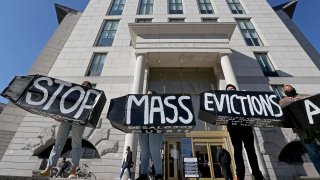
In addition to enhanced unemployment benefits and support for small businesses, the new bipartisan coronavirus relief bill introduced Monday provides much needed financial assistance for the tens of millions of Americans potentially facing eviction in the new year.
The bill provides for $25 billion in rental assistance for states and localities through the Coronavirus Relief Fund (CRF) and extends the national eviction moratorium through January 31, 2021.
The bill is a good start and should be "implemented immediately," but more aid is necessary in the long term, Diane Yentel, president and CEO of the National Low Income Housing Coalition (NLIHC), says in a statement.
"While extending the CDC eviction moratorium for one month is insufficient to keep people housed for the duration of the pandemic, the extension provides essential and immediate protection for millions of renters on the verge of losing their homes in January," Yentel says, noting that tenants in the U.S. owe an estimated $70 billion in back rent because of the pandemic.
Estimates vary of exactly how much emergency rental relief is needed to keep people stably housed — the NLIHC has been advocating for at least $100 billion in emergency rental assistance and housing vouchers — but Doug Rice, housing policy analyst at the Center on Budget and Policy Priorities (CBPP), says the $25 billion in the bipartisan bill is an important first step and should be delivered without delay.
"I'm very confident that the $25 billion will be well used," Rice says. "But I'm also confident more could be well used."
Who is eligible for emergency rental assistance
Households are eligible for assistance, according to the NLIHC, if the household income is below 80% of the area median income (this number varies by county and household size), and someone living there:
- Has qualified for unemployment benefits, has lost part of their income or has experienced financial hardship because of Covid-19, or
- Can show that they are at risk of losing their home
The new legislation allows landlords or utility companies to apply for the funds directly from cities and states, rather than giving the money directly to renters. Tenants must cosign the application if landlords apply on their behalf.
Money Report
Rice says that this is a helpful provision because tenants who need help do not always know that aid is available to them, because their states and localities don't do an effective job advertising it.
"You're likely to expand the reach of the money by adding landlords," he says, adding that the bill requires the money to be used to pay the tenant's rental obligations if landlords apply.
If landlords refuse the assistance, then renters can apply on their own and receive the assistance directly from the city or state, per the NLIHC.
Under the bill, each state would receive a minimum of $200 million to be used for emergency rental relief, per the NLIHC (territories and tribal communities would also receive some of the funds). At least 90% of the money must be used by the state for direct assistance, like back and future rent and utility payments. The remaining 10% could be used for things like eviction prevention and rehousing services.
Eviction crisis could exacerbate the virus
Evicting people in the middle of a global health crisis would exacerbate both the pandemic and existing health inequities in the U.S., according to a new paper from the Journal of Urban Health.
"Evictions often force families to live in overcrowded, unsanitary, and transient conditions," writes Sonya Acosta, a policy analyst at CBPP. They also disproportionately affect families and people of color, who are more likely to be behind on their rent, according to the CBPP's analysis of Census data.
Failing to provide needed financial aid to households would "cause more preventable deaths," Acosta writes.
Check out: The bipartisan coronavirus relief bill unveiled Monday includes more UI benefits—here's what to know
Don't miss: Personal loans often have lower interest rates than credit cards—these are the best 5 right now






